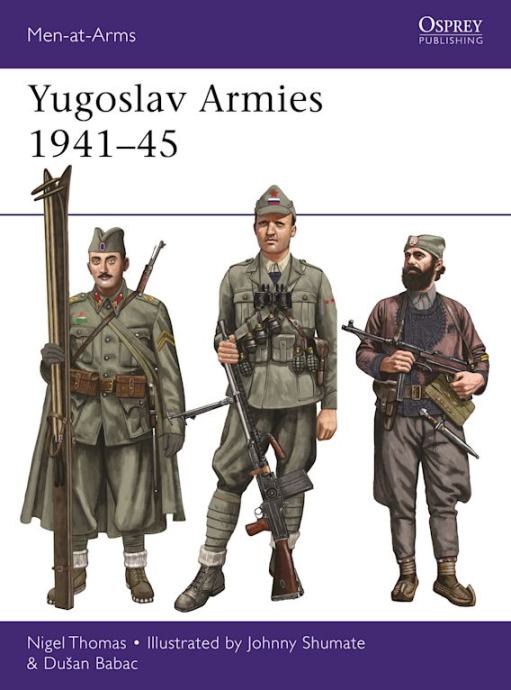Ta oglas ni aktiven.
Prebrskaj podobne oglase.
Osnovne informacije
- Vrsta ponudbe
- Prodam
- Lokacija
- Goriška, Nova Gorica, Solkan
- Stanje
- novo
Opis oglasa
Nigel Thomas, Dusan Babac in Johnny Shumate
Yugoslav Armies 1941–45
48 strani, mehka vezava, fotografije in ilustracije.
Kratek opis v angleškem jeziku:
In March 1941, an anti-German coup in the Kingdom of Yugoslavia prompted Hitler to order an invasion using allied Italian, Hungarian, Bulgarian and Romanian forces. Operation Marita was an invasion of Yugoslavia and simultaneously Greece. At the same time, the constituent region of Croatia broke away from Yugoslavia and joined the Axis powers. Royal Yugoslav armed forces, despite advancing against the Italians in Albania were forced to surrender after 11 days' fighting and some 1,000 soldiers, airmen and sailors escaped to British-occupied Egypt to form Free Yugoslav units. From there, guerrilla resistance to the Axis occupiers broke out and continued with increasing strength until the end of the war under Mihailovic's royalist 'Chetniks' and Tito's Communist 'Partisans' (both supported by Britain). However, hostilities between the two movements eventually led to the Chetniks entering into local agreements with Italian occupation forces and Britain switching its support entirely to the Partisans. The advance of the Red Army increased Partisan strength and, during 1944–45, they created what could be described as a lightly equipped conventional army.
Using meticulously-drawn illustrations of different insignia, uniforms and equipment from each faction to bring the conflict alive, this volume describes, in detail, both the political and military implications of the war and how it was fought, setting the scene for the subsequent rise of Tito to power within Yugoslavia.
Table of Contents
INTRODUCTION
-Birth of the Yugoslav state
-Inter-war developments
THE YUGOSLAV ARMY IN 1941
-Army Groups
-Uniforms
-Branch-specific items
-Rank titles & service-uniform insignia
THE APRIL WAR, 6–18 APRIL, 1941
-Order of battle & anticipated plans
-Campaigns
ROYAL YUGOSLAV FORCES IN THE MIDDLE EAST, 1941–45
-Royal Guards Battalion
- Uniforms & insignia
-7 (Yugoslavian) Troop, No. 10 (Inter-Allied) Commando
-Yugoslav Air Force
YUGOSLAV ARMY IN THE HOMELAND, 1941–45
-1941: Formation of the Chetniks
-1942: Establishment
-1943: Civil war
-1944: The defence of Serbia
-1945: Defeat
-Uniforms & insignia
YUGOSLAV PEOPLE'S LIBERATION ARMY, 1941–45
-1941: Organization
-1942: Organization
-1943: Organization
-1944: Campaigns
-1945: Campaigns
-Uniforms & insignia
SELECT BIBLIOGRAPHY
PLATE COMMENTARIES
INDEX
Kliknite na "vsi oglasi tega prodajalca", na voljo preko 500 različnih knjig z vojaško, zgodovinsko in letalsko tematiko.
Poštnino plača kupec, osebni prevzem je možen v Solkanu, oziroma Novi Gorici in bližnji okolici.
Yugoslav Armies 1941–45
48 strani, mehka vezava, fotografije in ilustracije.
Kratek opis v angleškem jeziku:
In March 1941, an anti-German coup in the Kingdom of Yugoslavia prompted Hitler to order an invasion using allied Italian, Hungarian, Bulgarian and Romanian forces. Operation Marita was an invasion of Yugoslavia and simultaneously Greece. At the same time, the constituent region of Croatia broke away from Yugoslavia and joined the Axis powers. Royal Yugoslav armed forces, despite advancing against the Italians in Albania were forced to surrender after 11 days' fighting and some 1,000 soldiers, airmen and sailors escaped to British-occupied Egypt to form Free Yugoslav units. From there, guerrilla resistance to the Axis occupiers broke out and continued with increasing strength until the end of the war under Mihailovic's royalist 'Chetniks' and Tito's Communist 'Partisans' (both supported by Britain). However, hostilities between the two movements eventually led to the Chetniks entering into local agreements with Italian occupation forces and Britain switching its support entirely to the Partisans. The advance of the Red Army increased Partisan strength and, during 1944–45, they created what could be described as a lightly equipped conventional army.
Using meticulously-drawn illustrations of different insignia, uniforms and equipment from each faction to bring the conflict alive, this volume describes, in detail, both the political and military implications of the war and how it was fought, setting the scene for the subsequent rise of Tito to power within Yugoslavia.
Table of Contents
INTRODUCTION
-Birth of the Yugoslav state
-Inter-war developments
THE YUGOSLAV ARMY IN 1941
-Army Groups
-Uniforms
-Branch-specific items
-Rank titles & service-uniform insignia
THE APRIL WAR, 6–18 APRIL, 1941
-Order of battle & anticipated plans
-Campaigns
ROYAL YUGOSLAV FORCES IN THE MIDDLE EAST, 1941–45
-Royal Guards Battalion
- Uniforms & insignia
-7 (Yugoslavian) Troop, No. 10 (Inter-Allied) Commando
-Yugoslav Air Force
YUGOSLAV ARMY IN THE HOMELAND, 1941–45
-1941: Formation of the Chetniks
-1942: Establishment
-1943: Civil war
-1944: The defence of Serbia
-1945: Defeat
-Uniforms & insignia
YUGOSLAV PEOPLE'S LIBERATION ARMY, 1941–45
-1941: Organization
-1942: Organization
-1943: Organization
-1944: Campaigns
-1945: Campaigns
-Uniforms & insignia
SELECT BIBLIOGRAPHY
PLATE COMMENTARIES
INDEX
Kliknite na "vsi oglasi tega prodajalca", na voljo preko 500 različnih knjig z vojaško, zgodovinsko in letalsko tematiko.
Poštnino plača kupec, osebni prevzem je možen v Solkanu, oziroma Novi Gorici in bližnji okolici.
Zemljevid
Opomba: prikaže se približna lokacija vašega oglasa
- Oglas je objavljen
- 27.11.2025. ob 08:36
- Do poteka še
- oglas je potekel
- Oglas je prikazan
- 1259 -krat

